
An enormous theorem: the classification of finite simple groups

Daniel Gorenstein
"In February 1981 the classification of finite simple groups was completed." So wrote Daniel Gorenstein, the overseer of the programme behind this classification: undoubtedly one of the most extraordinary theorems that pure mathematics has ever seen.
It should have been a landmark for modern mathematics, but it failed to attract much attention in the wider media, and even within the subject many people were sceptical. The reason was the mysterious and controversial nature of its proof. At over 10,000 pages, spread across 500 or so journal articles, by over 100 different authors from around the world, it was without precedent, and must be counted the longest in history.
The sceptics were proved right, up to a point: problems with the proof were subsequently discovered. The biggest took Michael Aschbacher and Stephen Smith seven years and two further books of work to resolve. In 2004, after this had been accomplished, Aschbacher wrote "to my knowledge the main theorem [of our paper] closes the last gap in the original proof, so (for the moment) the classification theorem can be regarded as a theorem".
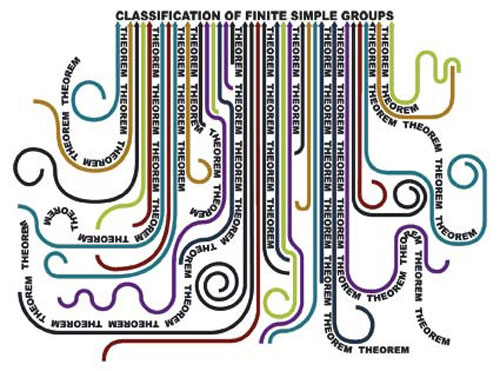
Pulling together the strands of mathematics.
For such a ground-breaking piece of contemporary mathematics, it's amazing that no-one in the world today completely understands the whole proof. The person with the best overall perspective on it was Gorenstein, who died in 1992. Gorenstein acted as coach to the team-effort to prove the enormous theorem. It was he, at a series of seminars in Chicago in 1972, who outlined the bold idea of taking various disparate strands of research which had emerged since the 1950s, and turning them into a concerted classification program.
So what is this astounding theorem, that requires a proof of such colossal length and complexity? What are "finite simple groups", and what does it mean to "classify" them? In this article I'll try to shed a little light on these questions, but first we'll need to take a few steps back.
Abstraction: precision and power

A cube has six faces, each is a square.
Mathematics often proceeds from the specific to the general. We start with an interesting object, for instance a cube. There are many observations you could make about a cube, but a mathematician might focus on its composition: it's a 3-dimensional solid, with flat 2-dimensional faces which meet at straight edges and vertices (corners). Such an object is called a polyhedron. You might then notice that a cube is a rather special polyhedron: all the faces have the same shape, all the edges have the same length, and the same number meet at every vertex. Polyhedra like this are called regular polyhedra.
So starting from a cube, we have discovered a more general type of object, a regular polyhedron, of which our cube is now just an example. Another example is a tetrahedron, which has four triangular faces.
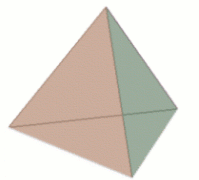
A tetrahedon has four faces, each is an equilateral triangle.
This movement from the specific — the cube — to the general — the idea of a regular polyhedron — is the process of abstraction. Abstraction is central to mathematical thinking; without it there would be no maths. There are two reasons for its importance.
The first is precision: if you're working on a question about a class of mathematical objects, then by paring them down to their logical essence, and cutting out all the distracting noise, it often becomes clearer what the nub of the problem is. So finding an answer to your question can become a lot easier.
The second advantage is power: if you have proved something about regular polyhedra, then what you have proved automatically holds true for every polyhedron, whether it's a cube, a tetrahedron, or some polyhedron that you have never even heard about.
All the ideas that mathematicians work with are arrived at by this process of abstraction, and none is more important than that of a group.
Groups: abstracting from addition
Let's think about all the whole numbers, or integers:
{... ,-3,-2,-1, 0, 1, 2, 3, ...}
together with the process of addition. You might notice three simple facts:
- if you add two integers together you get another integer;
- there is a special integer, 0, which does nothing when added to any other;
- from any integer, x say, you can get to 0 by adding its negative, -x.
- the combination of any two objects is also an object in our set;
- there's one special object that when combined with any other object leaves the other object unchanged (let's call this special object 0);
- for every object in your set there always is another object, so that the combination of the two gets us back to 0.
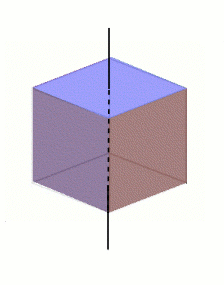
This axis passes through opposite faces of the cube. You can rotate it about this axis through 90, 180 and 270 degrees without changing its appearance. There are three different axes of this type, giving us a total of 9 rotations that leave the cube unchanged.
So, having abstracted from the integers and come up with the notion of a group, what other examples are there? It's no exaggeration to say that groups are everywhere in mathematics. They come in both finite and infinite varieties. The whole numbers discussed above give us an infinite group, because there are infinitely many of them. Of primary concern in this article though are the finite groups.
The cube can provide us with an example of a finite group: not the cube itself, but its collection of rotations. If I were to push a needle through the middle of the cube (through the centres either of two opposite faces, or of two opposite edges, or through two opposite vertices), then I could rotate the cube around this axis, so that some or all of the faces swap places. Unless you have labelled the faces, edges, or vertices, the cube will appear unchanged after such a rotation.
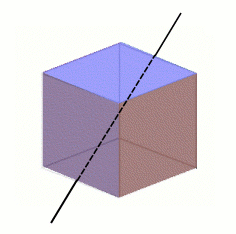
This axis passes through opposite edges of the cube. You can rotate it about this axis through 180 degrees without changing its appearance. There are six different axes of this type, giving us a total of 6 rotations that leave the cube unchanged.
The collection of all possible such rotations of the cube forms a group: if you perform one rotation and then a second, the combination is equivalent to performing a third (this is not immediately obvious); there is a rotation which does nothing at all (namely leaving the cube alone); and when you have performed any rotation you can get back to your starting position by doing your rotation backwards (or by rotating in the same direction so that the total angle of rotation amounts to 360 degrees).
It's not hard to see that there are 24 distinct rotations: 9 corresponding to having the axis through two opposite faces, 6 if the axis is through two edges, 8 if the axis is through two vertices, and the one trivial rotation which leaves it alone. These 24 rotations are called the elements of the group of rotations. Thus, the rotations of a cube form a finite group, in contrast to the group of whole numbers, which is infinite.
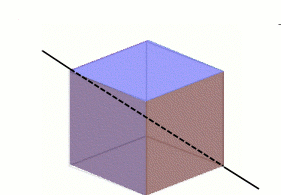
This axis passes through opposite vertices of the cube. You can rotate it about this axis through 120 and 240 degrees without changing its appearance. There are four different axes of this type, giving us a total of 8 rotations that leave the cube unchanged.
Of course we didn't have to start with a cube. For each regular polyhedron, there is a finite rotation group. In fact, mathematics is full of geometric structures, much more abstract than our regular polyhedra. Nonetheless, they often have automorphism groups associated to them, which relate to them (roughly speaking) in the same way as the group of rotations relates to the cube.
Classification: pinning down the abstract
If abstraction provides mathematicians with their objects of study, the theorems they try to prove often go the other way: from the general to the specific. They try to classify these abstract objects, that is to say to give a detailed and exhaustive list of all the objects which satisfy the definition.
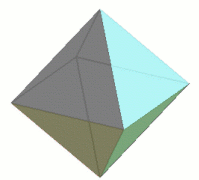
An octahedron has eight faces, each an equilateral triangle.
For example, having arrived at the notion of a regular polyhedron from the example of the cube, there is a corresponding classification theorem (which was known to the ancient Greeks). It states that every regular polyhedron, must be one of the Platonic solids: either a tetrahedron, a cube, an octahedron, a dodecahedron, or an icosahedron.
This is no longer just a list of examples, the fact that each of the Platonic solids is a regular polyhedron is only half the point. The other half is that there are no other regular polyhedra.
This is exactly the sort of theorem that researchers in many areas of mathematics would absolutely love to prove. So finite group theorists have achieved a truly enviable result. However, their classification doesn't apply to the class of all finite groups, just to one particularly important subclass.
Simple groups: algebra's atoms
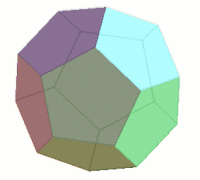
A dodecahedron has twelve faces, each being a regular pentagon.
The definition of a simple group is technical, but the idea is easy: just as a prime number is a number which cannot be factorised into two smaller numbers, so a group is simple if it cannot be broken up into two smaller groups.
As an example, let's go back to our cube and imagine that we've stuck a skewer through the mid-points of two opposite faces. We can rotate the cube around this axis by 90, 180, or 270 degrees without changing its appearance, and we can also leave it alone and do nothing. These four rotations, doing nothing and rotating through 90, 180 and 270 degrees, are four of the 24 elements of our rotation group.
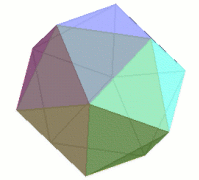
An icosahedron has twenty faces, each is an equilateral triangle.
However, they themselves also form a smaller group, as you can easily check. Doing two of these rotations in sequence, say first the 90 degree and then the 180 degree one, amounts to doing one of the other two, in this case the 270 degree one. There's the trivial rotation of doing nothing. And if you've done one rotation, say the 90 degree one, then following it by one of the other four, in this case the 270 degree rotation, gets you back to where you started. So these four rotations together satisfy our three characteristics that define a group.
Thus, the full group of rotations of a cube contains smaller groups that sit within it. Essentially, although the precise definition is more technical, a simple group is one that cannot be broken up into smaller groups in this way. Maybe one lesson to be learnt from the classification is that mathematicians should be more careful when naming things!
The importance of simple groups stems from the Jordan-Hölder Theorem, proved around 1889. It tells us that just as all molecules are built from atoms, and all positive integers are built from prime numbers, so all finite groups are built from finite simple groups. Once you understand the finite simple groups, you understand a lot about all finite groups.
The classification: anything but simple
Just as in the case of regular polyhedra, the classification of finite simple groups provides a complete list of all the finite simple groups. However there is a difference: this time the list is infinite; there are infinitely many distinct finite simple groups.
But despite their infinite number, mathematicians understand them well. There are precise descriptions of 18 infinite families of finite simple groups. The definitions are highly technical and delicate, but essentially they are obtained from families of automorphism groups of certain geometric structures. They are abstract analogues of the rotation groups of our regular polyhedra.
On top of these 18 families, there are 26 individual groups, the so-called sporadic groups. The largest of these is called the Monster and weighs in at 808,017,424,794,512,875,886,459,904,961,710,757,005,754,368,000,000,000 elements!
So now we understand what the classification of finite simple groups says: every finite simple group either belongs to one of the 18 families, or is one of the 26 sporadic groups.
After the classification: where now?
When the classification was announced, some people jumped to the conclusion that finite group theory had reached its end. But many mathematicians are still working in the area today. What are they doing?
One thing they're doing is simplifying the proof. Although the statement of the classification has already been very useful in a range of mathematical areas, a vast and impenetrable proof which no-one understands is of no use to anyone. There is a real risk that if the techniques get forgotten before the proof is put into an accessible form, then, in the words of Gorenstein, "it will gradually become lost to the living world of mathematics, buried deep within the dusty pages of forgotten journals".
So there are currently several projects afoot to consolidate and simplify parts of the proof. Perhaps the most significant was initiated by Gorenstein, along with Richard Lyons and Ronald Solomon, and is still ongoing: to produce a self-contained, slimmed down second generation proof, fully written down in one place. This is being done in a series of books being published by the American Mathematical Society. It is expected that they will number about twelve, and stretch to a total of 3,000-4,000 pages. At time of writing, 6 have been published so far.
A second major theme in finite group theory is the extension problem for finite groups. If simple groups are analogous to atoms, then it's worth noting that chemistry was far from finished when the Periodic Table was first published. Chemists wanted to understand the ways in which atoms could combine to form bigger molecules. So what are the equivalents of covalent and ionic bonds in the case of finite groups? What limits are there on the compound structures which can be built? A complete answer to this question would constitute a classification of all finite groups. But this isn't thought to be a viable goal at present. In full generality it seems inaccessibly hard. However various instances of the extension problem form the focus of much mathematical attention.
So much for finite groups. What about infinite groups? Is it feasible that something similar could be done there? Again, probably not in full generality: infinite groups come in a bewildering variety of forms. But this has led some mathematicians to look for tame subclasses of infinite groups, which might be amenable to this sort of analysis. Much of the current drive in this area rests on emulating the powerful techniques used in the classification of finite simple groups.
About this article
This article is the winner of the general public category of the Plus new writers award 2006.
The article now forms part of our coverage of a major research programme on group theory held at the Isaac Newton Institute for Mathematical Sciences (INI) in Cambridge. The INI is an international research centre and our neighbour here on the University of Cambridge's maths campus. It attracts leading mathematical scientists from all over the world, and is open to all. Visit www.newton.ac.uk to find out more.

About the author

Richard Elwes studied maths at Oxford University between 1997 and 2001 and then did a PhD in model theory (a branch of mathematical logic) at Leeds University, which he completed in November 2005. After a very enjoyable 6 months of postdoctoral research in Freiburg in Germany, he's now back living in Leeds. Apart from researching and teaching mathematics, he enjoys writing on a range of subjects from politics to horror-films, and is absolutely delighted to have won the general public category of the Plus New Writers Award 2006!
Comments
Anonymous
Richard Elwes
Re the New Scientist article 'it doesn't add up', (New Scientist, Vol 207, No. 2773, pp34-38) is fascinating. The whole area of infinities and number theory is wonderful and, as a science trained artist, has captured my imagination since childhood.
The Nature of the Infinity Boundary.
I would agree with Doron Zeilberger - in the sense that its a nonsense to consider that as we count up numbers we eventually continue until 'infinity'. Of course, there is no magnitude limit!. We can always add one to whatever an 'infinite' number is. So what is the nature of the boundary of this infinity?
Let us consider that, in the extremely simple case of integer number, the infinity boundary in this case may be understood to describe a 'realm of quality' - a dimension-like entity with an 'attribute boundary'.
We can make sense of this boundary, which defines the reality of infinity (of integer number), if it describes the boundary of an unambiguous 'realm of all integer number' - an attribute boundary describing a realm of quality of number - in this case the realm of 'All Integer Number'. The set of all integer number if you like. But in this case the 'set' is not merely a collection of numbers, it is invested with dimension-like properties.
So the reality of the 'infinity', in the case of integer number, can be understood by observing it from the 'ouside', in which case we see a dimension-like attribute boundary, a phase boundary, rather than any kind of simplistic, ambiguous and nonsensical 'magnitude limit' (which has no limit), which is of course, nonsense. As an integer number becomes increasing large it becomes more dimension-like (cf limit condition as the dimension-like realm of quality of All Integer Number), whereas 'smaller' numbers are more 'particle' like with the quantum of 1 as the smallest integer unit.
best wishes,
dallas simpson,
location performance environmental sound artist.
Anonymous
Thanks.
Your article shed some light on something that makes little sense to me but I find very interesting.
Bill
Anonymous
This article beautifully provided the motivation and intuition behind the idea of groups, something that had escaped me despite having spent some time trying to familiarize myself with the language and formal textbook-style definitions available on the subject. I eagerly look forward to delving back into my studies on group theory, knowing that now I can see 'sense' behind the erstwhile impenetrable curtain of equations.
Anonymous
This article does a fine job of disspelling the myth that group theory has no post-classification future. There is no scientific basis for this myth, since groups emerge wherever there is symmetry, and symmetry emerges wherever there is nature.
I really like the author's analogy (chemistry and the extension problem), however I wish to point out one small caveat that as well contributes to the intractability of the extension problem. Whereas every molecule is comprised of atoms, it is not the case that every finite group is comprised of finite simple groups. I speak here of the "nonsplit extension". To fit this case into the author's analogy (at least the 2-step version), one would have to imagine a molecule that consists of only one atom, but also some additional material that is defnitely not an atom. However, were that atom in this molecule to collapse to a singularity, then the molecule iteself would become another atom ... evidently one that was never present in the molecule to begin with.
Again, excellent article.
- Doc
Anonymous
This article does a fine job of disspelling the myth that group theory has no post-classification future. There is no scientific basis for this myth, since groups emerge wherever there is symmetry, and symmetry emerges wherever there is nature.
I really like the author's analogy (chemistry and the extension problem), however I wish to point out one small caveat that as well contributes to the intractability of the extension problem. Whereas every molecule is comprised of atoms, it is not the case that every finite group is comprised of finite simple groups. I speak here of the "nonsplit extension". To fit this case into the author's analogy (at least the 2-step version), one would have to imagine a molecule that consists of only one atom, but also some additional material that is defnitely not an atom. However, were that atom in this molecule to collapse to a singularity, then the molecule itself would become another atom ... evidently one that was never present in the molecule to begin with.
Again, excellent article.
- Doc
Anonymous
Will find places to apply these. Could glimpse an open field.
Anonymous
Your definitions lack one important property: The group operation must be associative. For any a,b,c in G, (A*B)*C must be the same as A*(B*C)
Anonymous
Why?
Anonymous
Because that is a property even of a semigroup...
Anonymous
This article is very well written, but I must object to the implications of the statement that "no-one in the world today completely understands the whole proof." Of course, complete understanding is a high benchmark to set. But I would argue that Thompson, Aschbacher and Lyons understand the proof at least as well as Danny Gorenstein did, and Steve Smith and I (and probably several others) come pretty close. See our book which received the AMS Steele Prize for Mathematical Exposition. Danny Gorenstein deserves enormous credit for conceiving and daring to articulate the strategy of the proof back in 1971-72. But his overall perspective did not die with him.
Ron Solomon